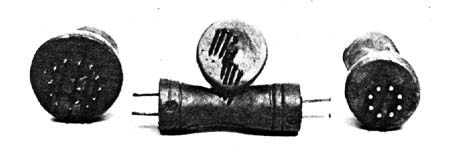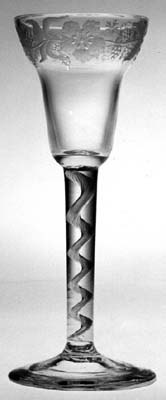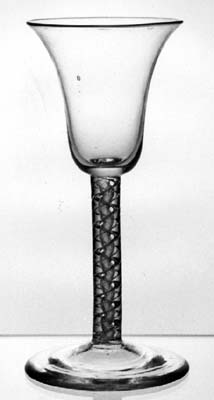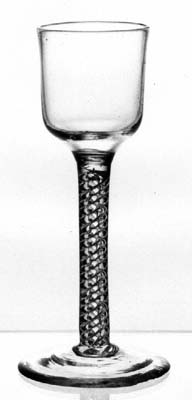
When examining glasses with air-twist stems one has to remind oneself that this decoration is actually made of "nothing" -- just air! The gleaming stems of the air-twist glasses must have been very effective in the candle-lit rooms of eighteenth century manor houses. Unfortunately this attractive feature is somewhat muted in the photographs contained in this file because back-lighting was chosen in order to show the intricacies of the twisted patterns. The physical property of surface tension permits each strand of air to remain continuous, even when closely packed together as in a cable twist. All English twists spiral downward and to the left.
The following photograph, taken from Wilkinson (1968, p. 27), shows four variations of the tool used in making air-twist stems. Apparently it has no special name; Wilkinson sometimes calls it a "plunger", typically constructed with "steel prongs fitted through a steel plate and screwed to a wooden handle".

To form an air-twist stem the above tool, with its blunt, nail-like prongs, was used to make indentations in the soft glass-metal at the base of the glass's bowl which remained attached to the blowpipe (below, upper left). These indentations were immediately sealed by rubbing them, or by covering them with molten glass, thus trapping bubbles of air. After reheating the vessel the stem was formed by drawing out the glass from the bottom of the bowl and twisting it, causing the bubbles to become elongated into a spiral as illustrated by the trumpet bowl below, left. The foot was then attached, resulting in a two-part glass.


In a typical three-part glass, illustrated by the round funnel bowl above, upper right, a glob of molten glass that would eventually form the stem was attached to the base of the glass's bowl. After being pricked by the tool -- resulting in the group of bubbles shown -- the glob was pulled and twisted to form the stem, often resulting in a more prominent knop ("lump") than is shown in the illustration above, lower right. The third part of the glass, its foot, was then applied. (All sketches are taken from Wilkinson 1968, p. 28.)
An air-twist stem drawn out of the base of a bowl, giving a two-piece glass, risks mishap; a three-piece glass permits the stem to be prepared in advance, with enhanced chances of success. Both methods had their teething troubles. In the two-piece glass the twist was frequently irregular at the top, and occasionally petered out below. In the three-piece glass there was often difficulty in keeping the air-threads even. By the middle of the [eighteenth] century these difficulties seem to have been mainly overcome. (Charleston 1984, pp. 146-147)Each glass illustrated in this file is concisely described by its caption, where a few standard abbreviations are used. A single formation of twisted air is called a single-series air twist or SSAT. The most common type of SSAT has several twisted strands of air and is, therefore, called a multiple-spiral air twist or MSAT. A twist that contains two distinct formations, one wound around another, is a double-series air twist or DSAT. Haynes (1959), whose work has been discussed elsewhere, found that about fourteen percent of the thousands of glasses that he examined could be classified as air twists. Commonly found bowl shapes include the round funnel (RF) and the bell. Most feet are conical in shape.
The wine glass on the left, below, is the heaviest of the air twists illustrated in this file. It is a two-part glass, as indicated by the air strands which are continuous, from bowl to stem. Because of the amount of metal used, it is believed that this glass could pre-date imposition of the glass excise tax (1746) when metal in the pot was taxed by weight. In this example, the foot is gently terraced. The multiple spiral was made by using a multi-pronged "plunger" similar to the two shown above, left and right.
The glass in the center, below, epitomizes the expression "Georgian grace". It is a finely shaped, three-part glass with excellent proportions. Two or more knops can sometimes be found in the stems of glasses of this type.
Multiple reflections can cause air twists to appear as if they contain quicksilver, especially if the twists have fairly large and flat cross-sections. The nickname "mercury twist" is sometimes given to these glasses, such as the cordial on the right, below, whose stem would have been made by using a "plunger" with a flat pair of prongs, such as the tool shown above, center bottom (right-hand side).
LEFT: Wine glass; drawn bell bowl with a MSAT extending into bowl; solid base; terraced foot; c1740; H = 6.75" (17.1 cm); $340. CENTER: Wine glass; bell bowl; shoulder-knopped MSAT stem; c1750; H = 6.5" (16.5 cm); $90. RIGHT: Cordial glass; RF bowl; SSAT -- pair of alternating spiral threads (corkscrews); c1750; H = 5.25" (13.3 cm); $140.



The glass on the left, below, is the last example of a SSAT in this file; in this case it is a cable twist. The significance of this glass, with its possible Jacobite association, is discussed after the following brief comments concerning the only examples of double-series air twists that were purchased during 1986 and 1987: These DSAT glasses below, center and right, are considered scarce. Haynes (1959) found that, of his group of air twists, only one glass in nine had a double-series air-twist stem. DSAT glasses were made by using "plungers" similar to the one shown above, center top, which has a single, thick prong surrounded by two sets of four prongs each.
LEFT: Wine glass; wheel-engraved pan-topped RF bowl; SSAT -- spiral cable; c1745; H = 6.5" (16.5 cm); $325. CENTER: Wine glass; bell bowl; DSAT -- alternating pair of spiral threads outside a vertical gauze; chip on foot; c1755; H = 7.1" (18.0 cm); $160. RIGHT: Wine glass; ogee bowl; DSAT -- four spiral threads outside a two-strand vertical cable; chipping on foot rim; c1755; H = 6" (15.2 cm); $88.



The story of Bonnie Prince Charlie and the
attempt by the Jacobites to restore the Stuart Dynasty to the British throne
during the eighteenth century is a romantic, and enduring, one. Because
supporters of the Prince were subject to arrest for treason, they formed secret
societies that were also drinking clubs with extensive rituals known only to
members. Drinking glasses played a significant part in this underground
activity.
Today there is general agreement regarding many of the secret symbols that are found engraved on glasses that are known to have belonged to the societies, and to individual supporters, of the Jacobite cause. This opposition to the British crown began during The "Glorious" Revolution of 1688 and reached a peak of activity during the 1740s when the Bonnie Prince led an abortive uprising ("the Forty-five"). The wine glass, above left, was probably made about this time.
The principle group of secret symbols engraved on a so-called Jacobite glass consists of items such as the rose, rose buds, radiating star, oak
leaf, etc. In addition there is the possibility that a group of secondary
symbols, as illustrated below, might also have been in use. These images are
close-ups of the top inch or so of the pan-topped wine glass shown above. Between the
flowers there is "the gadding vine" with its bunches of grapes. In spite of its
tiny size each grape has been polished, as have parts of the flowers -- in
A and D especially. Wheel-engravings of this quality are not
commonly found on glassware made in England during the middle of the eighteenth
century. If the engraving were contemporary with the glass itself -- and there
is little doubt that it is -- some experts would maintain that it was done by
immigrants, probably from central Europe, where the technique of wheel-engraving
was more advanced and established than in England.
Of course, the floral frieze on this glass might simply represent examples of popular blooms. Nevertheless, it could, just possibly, represent aspects of the Stuart/Jacobite cause shown in disguise. It has been suggested (Haynes 1959) that the flowers might represent the following aspects of the cause: A, Carnation = Prince Charles (the Young Pretender to the throne); B, Honeysuckle = Prince Henry, his younger brother; and C, Passion Flower = the Stuart cause itself. If the flower in D is the Christmas Rose then it could be interpreted as representing the white rose, symbol of the House of Stuart. Whether or not there is a Jacobite association -- and the question may never be answered -- the wine glass should be viewed as a whole. The cable twist, the undulating profile of the bowl, and the informal, naturalistic engraving all combine in a fine example of eighteenth century English rococo style in glassware (Thorpe 1961).

The reader can find a modern summary of Jacobite activity as it relates to propaganda glasses in Robertson (1969, pp. 97-108).
Updated 21 Jul 2002